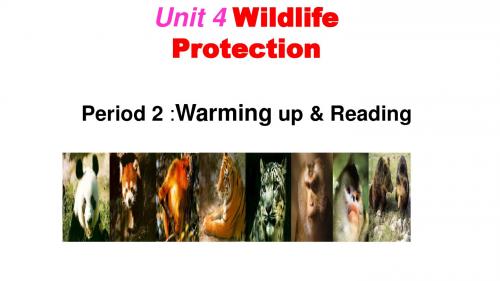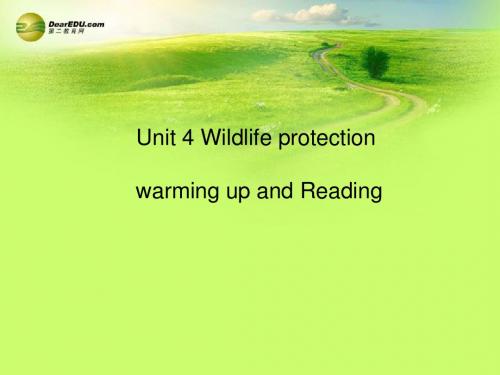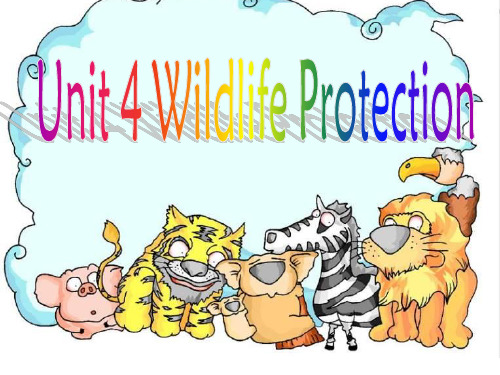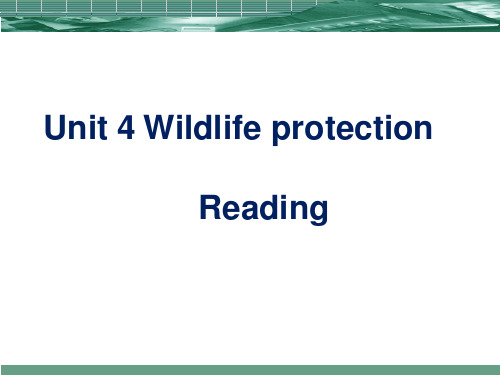Unit4 wildlife protection warming up
- 格式:ppt
- 大小:5.72 MB
- 文档页数:42



Unit 4 Wildlife ProtectionThe first periodWarming upKnowledge aims:a. help Ss to understand and master the words and expressions in warming up.b. Let the students know some basic information about the endangered animals and wildlife situation and protection.Ability aims:Encourage Ss to think and express their attitude towards the wildlife and the wildlife protection.Emotional aims:a. Help Ss understand the importance of the wildlife protection and make them be more active in the helping wildlife.b. Develop Ss’ sense of cooperative learning.Teaching Key Points:Enable the students to know some basic information about the endangered animals and wildlife protection.Encourage Ss to think and express their attitude towards the wildlife and the wildlife protection.Teaching Difficult Points:How to enable the students express themselves freely.Teaching Materials:Blackboard, multi-media, and other normal teaching tools.Teaching methods:Co-operative learningStudents-centered approach & Task-based teaching and learningTeaching Procedures:Step 1: Lead-inLead in by explaining the title and predicting what will be learned in this lesson. Step 2: ExplorationTask: let the students explore the following question:What is the problem of wild animals commonly facing?1. Show some pictures to the students. Students watch the pictures and say what the pictures tell us.References: food shortage, pollution, destruction of habitat, over-hunting.2. Show the students three more pictures and ask: what do people kill or hunt these animals for?From these pictures, students can conclude that people kill animals for food, for fur, for medicine and for works of art.3. Ask the students to give their answers to the question: What is the problem of wild animals commonly facing?Step 3: Discussion1. Let the students discuss the following question: why should we pay attention to wild animals and plants.Students discuss the question in groups and then give their opinions.2. After discussion, tell students what is wildlife protection about.Step 4: Group work1. Let the students read the report on some endangered wildlife in China at page 25, SB.2. Ask the students some questions about the report.3. Let the students describe the chart in small groups according to the sample.4. Discussion. More and more animals are killed by humans, as a student what should you do to protect the wild animals?Step 5: HomeworkWrite a composition according to the tips.假如你是一名记者,采访某动物园负责人有关国宝大熊猫的情况。



Unit 4 Wildlife ProtectionWarming up and readingHow Daisy Learned to Help Wildlife教学设计●Teaching Aims: (教学目标)Knowledge aims: (知识目标)a. Ss can understand and master the words and expressionsb.Ss can understand the passage.c. Let the students know some basic information about theendangered animals and wildlife situation andprotection.Ability aims: (能力目标)a. Ss can think and express their attitude towards thewildlife and the wildlife protection.b. Ss will enhance their reading ability and develop Ss’ability and skills of guessing words and readingcomprehension.Emotional aims: (情感目标)a. Ss will understand the importance of the wildlifeprotection and make them be more active in the helpingwildlife.b. Ss can develop the sense of cooperative learning.●Teaching Key Points:(教学重点)a. Ss can train the reading comprehens ion to the whole passageb. Ss will improve the ability of listening, speaking, reading and writing.●Teaching Difficult Points: (教学难点)a. Ss can improve their reading skills in the passage.b. Ss can present their ideas of how to protect wildlife.● Teaching Materials: (教学材料)A projector, colorful paper, blackboard, books, and other normal teaching tools.● Teaching methods:(教学方法)Co-operative learningActivity-based teaching (individual work; group work; class work)Students-centered approach & Task-based teaching and learningTeaching Procedures: (教学过程)Step1 Leading inActivity: Watch a video.(两则关于野生动物保护的公益广告) T: Before our lesson, I will show you a video. (play the video)Ok ,what is it about?S: wildlife protection/ endangered animals.T: So today we are going to learn the topic: Wildlife ProtectionStep2 BrainstormingT: Well, in the video, tigers and elephants are endangered animals .Do you know any other endangered animals?S:milu deer antelope giant panda south china tiger golden monkeyStep3 TalkingWhy are they endangered?(show pictures and tips) Suggested answers:a. People killed the endangered animals for food.b. People kill animals for their fur, which can be made into beautiful and expensive fur coat.c.Their habitat is being threatenedd.They cannot find enough foodsummary: Reasons for their dying outThe loss of food Too much hunting Habitats being destroyed Step4. Fast readingFill in the tableTe st your reading speedPlaces she went toSuggested answers:antelope,Tibet ; elephant,Zimbabwe ;monkey,Rainforest 。
Unit 4 Wildlife protectionPeriod 1: Warming up and reading Teaching AimsTo talk about endangered speciesTo read about wildlife protectionProceduresI. Warming up by learning about animalsLook at the photos below and listen to me telling you about the animals, the endangered animals.II. Pre-reading1.Defining wildlifeWhat does the world wildlife mean?2.Make a list of other endangered wildlife in China that is being protected.3.Pre-reading questions:4.Reading to the recordingNow turn to page 26, listening and reading to the recording of the text. Try to keep pace with the native reader, making your reading resemble that of the reader, in speed, in intonation and in pronunciation.III. Reading1. Reading and getting informationNow you are to read the text for information to fill in the form.2.Reading and underliningNext you are to read the text and underline all the collocations at the same time.Period 2: Learning about LanguagePlaying a gameLet’s go on to play the game described on the top of the page 29. The following sentences are to be passed on.. Studying The Present progressive Passive Voice1. Passive VoiceThe passive voice is used when focusing on the person or thing affected by an action. The Passive is formed: Passive Subject + To Be + Past ParticipleIt is often used in business and in other areas where the object of the action is more important than those who perform the action. For Example: We have produced over 20 different models in the past two years. Changes to: Over 20 different models have been produced in the past two years.If the agent (the performer of the action) is important, use “by.” For Example: Tim Wilson wrote The Flight to Brunnswick in 1987.The Flight to Brunnswick was written in 1987 by Tim Wilson.Only verbs that take an object can be used in the passive.The following chart includes sentences changed from the active to the passive in the principal tenses.2. Passive Verb FormationThe passive forms of a verb are created by bining a form of the “to be verb.” with the past participle of the main verb. Other helping verbs are also sometimes present: “The measure could have been killed in mittee.” The passive can be used, also, in various tenses. Let’s take a look at the passive forms of “design.”IV. Reading and identifyingSince you are clear about Passive Verb Formation, go back to page 26 and scan the text for all the examples of The Present ProgressivePassive Voice.Now try to put the following sentences into The Present Progressive Passive Voice.▲They are producing this new drug.▲Antelope is looking at her.▲They are killing us for the wool.▲They are destroying the farm.Period 3: Using LanguageListening, Speaking and Writing1stPeriod1.Teaching important points:A.Improve students’ ability of extensive reading.B.Improve students’ a skills of listening.2.Teaching difficult points:A.How to finish the task in limited time.B.How to get the accurate information while listening.. Listening1.Explain the following difficult words to the students before listening:①once upon a time 曾经;很久以前②curious adj. 好奇的③wing n. 翅膀④trap n. 陷阱⑤spear n. 矛2.Listen to the recording of Dodo’s Story.3.Finish Ex 1 on p30.4.Check the answers (C D B C)5.Listen to the tape again and finish ex2 on P30Step 6 Homework1.Finish Ex. 21-55 on English Weekly 15th2.Review the language points in this unit.2ndPeriod1. Teaching important pointsA.How to use what their learnt in this unit.B.To express their opinions freely in the speaking task.2.Teaching difficult pointHow to write a letter.3.ProcedureStep 1. GreetingStep 2. Daily reportStep 3. RevisionReview the language points learnt in the former periods. Step 4. SpeakingGroup work to finish discussion about the topic on P 31Then invite some students to present their workStep 5. WritingPair work to discuss the topic of writing on P 31Give them 20 minutes to write a short letterStep 6. HomeworkFinish reading task on P 65。